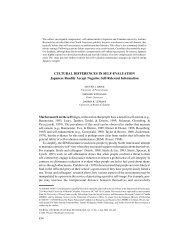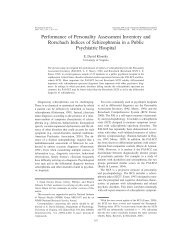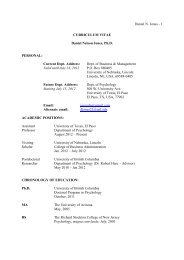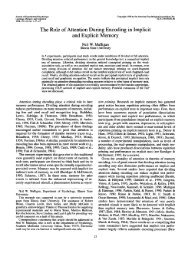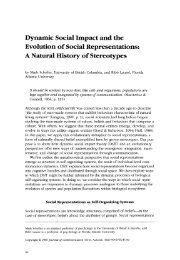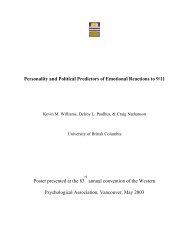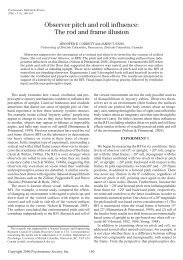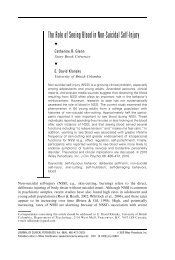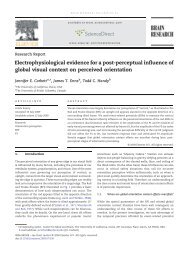Gestalt Grouping Principles - HomePage Server for UT Psychology
Gestalt Grouping Principles - HomePage Server for UT Psychology
Gestalt Grouping Principles - HomePage Server for UT Psychology
Create successful ePaper yourself
Turn your PDF publications into a flip-book with our unique Google optimized e-Paper software.
Perception, <strong>Gestalt</strong> <strong>Principles</strong> of 507<br />
Figure 8. <strong>Grouping</strong> by similarity in dense textures follows different rules from grouping by similarity of individual<br />
texture elements.<br />
Consider, <strong>for</strong> example, whether an L-shape or a<br />
tilted T-shape is more similar to an upright T-<br />
shape. When observers are shown this triplet of<br />
elements in isolation, they tend to agree that the<br />
tilted and upright Ts are more similar to each other<br />
than either one of these two is to the L-shape.<br />
However, as shown in Figure 8, when large<br />
numbers of these shapes are used to <strong>for</strong>m a texture,<br />
borders are <strong>for</strong>med where regions of uni<strong>for</strong>m elements<br />
meet one another. Now it is clear that the<br />
strongest border lies between the upright Ts and<br />
the tilted Ts (Beck, 1982). This demonstrates that<br />
similarity varies with the visual task. Seeing a<br />
dense texture of elements leads to an emphasis on<br />
differences in element orientation, whereas seeing<br />
elements in isolation permits an analysis of the<br />
spatial relations among component segments.<br />
In studies of perceived brightness and similarity,<br />
it has been shown that grouping depends on the<br />
apparent brightness, not on the physical luminance<br />
intensities of elements (Adelson, 1993;<br />
Rock, 1997). This means that observers take into<br />
account the role of shadows and assumed light<br />
sources in their evaluation of similarity based on<br />
luminance. As such, it also demonstrates once<br />
again that visual grouping does not operate in isolation<br />
from other perceptual processes, especially<br />
those involved in the interpretation of an image as<br />
being generated by light reflecting from threedimensional<br />
surfaces.<br />
References<br />
Adelson EH (1993) Perceptual organization and the<br />
judgment of brightness. Science 262: 2042±2044.<br />
Beck J (1982) Textural segmentation. In: Beck J (ed.)<br />
Organization and Representation in Perception,<br />
pp. 285±318. Hillsdale, NJ: Lawrence Erlbaum.<br />
Biederman I (1987) Recognition-by-components: a theory<br />
of human image understanding. Psychological Review 94:<br />
115±147.<br />
Enns JT and Rensink RA (1991) Preattentive recovery of<br />
three-dimensional orientation from line drawings.<br />
Psychological Review 98: 335±351.<br />
Field DJ and Hayes A (1993) Contour integration by the<br />
human visual system: evidence <strong>for</strong> a local `association<br />
field'. Vision Research 33: 173±193.<br />
Hochberg J (1982) How big is a stimulus? In: Beck J<br />
(ed.) Organization and Representation in Perception,<br />
pp. 191±218. Hillsdale, NJ: Lawrence Erlbaum.<br />
Julesz B (1984) A brief outline of the texton theory of<br />
human vision. Trends in Neuroscience 7: 41±45.<br />
Lee S-H and Blake R (1999) Visual <strong>for</strong>m created solely<br />
from temporal structure. Science 284: 1165±1168.<br />
Mack A and Rock I (1998) Inattentional Blindness.<br />
Cambridge, MA: MIT Press.<br />
Nakayama K and Silverman GH (1986) Serial and<br />
parallel processing of visual feature conjuctions. Nature<br />
320: 264±265.



